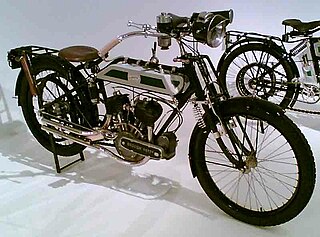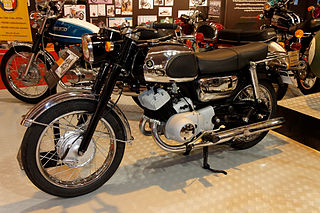
Berkeley Cars Ltd was a British car manufacturer based in Biggleswade, Bedfordshire. The company produced economical sporting microcars with motorcycle-derived engines from 322 cc to 692 cc and front wheel drive between 1956 and 1960.

Motobécane was a French manufacturer of bicycles, mopeds, motorcycles, and other small vehicles, established in 1923. "Motobécane" is a compound of "moto", short for motorcycle; "bécane" is slang for "bike."

Brough Motorcycles were made by William E. Brough in Nottingham, England, from 1902 to 1926, after some earlier experimentation with motorised tricycles. The Brough Superior company was a separate company created by his son, George Brough.
The Morris Isis name was first briefly used by Morris Motors Limited on a 6-cylinder car made from 1929 until 1931. It was resurrected on a new 6-cylinder midsize car from the British Motor Corporation in the 1950s to replace the Morris Six MS.

The Swift Motor Company made Swift Cars in Coventry, England from 1900 until 1931. It grew progressively from James Starley's Coventry Sewing Machine Company, via bicycle and motorised cycle manufacture. The cars ranged from a single-cylinder car in 1900 using an MMC engine, through a Swift-engined twin-cylinder 7-horsepower light car in 1904, and a 3-litre model in 1913. After the First World War a successful range was sold during the 1920s, but the Cadet of 1930 was its last vehicle as it could not compete economically with volume manufacturers such as Ford and Morris Motors.

Matchless is one of the oldest marques of British motorcycles, manufactured in Plumstead, London, between 1899 and 1966. A wide range of models were produced under the Matchless name, ranging from small two-strokes to 750 cc four-stroke twins. Matchless had a long history of racing success; a Matchless ridden by Charlie Collier won the first single-cylinder race in the first Isle of Man TT in 1907.

Bond Minicar is a series of economical three-wheeled microcars which were manufactured by the British car manufacturer Sharp's Commercials Ltd, in Preston, Lancashire, between 1949 and 1966.

Douglas was a British motorcycle manufacturer from 1907 to 1957 based in Kingswood, Bristol, owned by the Douglas family, and especially known for its horizontally opposed twin cylinder engined bikes and as manufacturers of speedway machines. The company also built a range of cars between 1913 and 1922.
The Elfe was a French automobile, manufactured in Lavallois, Paris, from 1919 until about 1925 by Ateliers Defrance Freres. The company was founded by M. Eugene Mauve, who was also the instigator of the Bol d'Or race for cyclecars and latterly motorcycles, now held at the Le Mans circuit in France. During its brief life, the company entered numerous races, under various names including ELFE, Elfe-Anzani, Elfe-DeFrance and Mauve.
The Rover 8 was a small single-cylinder 8 hp 1327 cc car made by the British Rover car company. It was Rover's first production car. It was remarkable for being supported by a backbone chassis rather than a conventional ladder frame. The first model was manufactured from 1904 to 1912. A Daimler-Knight sleeve valve engine option was available on the original model in 1911 and 1912.

A motorcycle frame is a motorcycle's core structure. It supports the engine, provides a location for the steering and rear suspension, and supports the rider and any passenger or luggage. Also attached to the frame are the fuel tank and battery. At the front of the frame is found the steering head tube that holds the pivoting front fork, while at the rear there is a pivot point for the swingarm suspension motion. Some motorcycles include the engine as a load-bearing stressed member; while some other bikes do not use a single frame, but instead have a front and a rear subframe attached to the engine.

ABC motorcycles was a British motorcycle manufacturer established in 1914 by Ronald Charteris in London. Several British motorcycle firms started up with the name "ABC", including Sopwith. The All British Engine Company Ltd. of London was founded in 1912 and later changed to ABC Motors Ltd. With chief engineer Granville Bradshaw, Charteris built a range of engines throughout the First World War. From 1913 ABC produced motorcycle engines.
The Hesketh V1000 is a 992 cc (60.5 cu in) OHC V-twin motorcycle with 4 valves per cylinder. It was originally designed and built by Hesketh Motorcycles in Daventry, Northamptonshire. Sales proved disappointing as the motorcycle was expensive and, at 86 bhp, it was somewhat underpowered given its hefty dry weight of 244 kg (538 lb).

The Bignan was a French automobile manufactured between 1918 and 1931 on the north side of central Paris, in Courbevoie. The business was created, and till the mid 1920s-headed up, by Jacques Bignan.

Bridgestone motorcycles were a division of the Bridgestone Tire Co. of Kyōbashi, Tokyo, Japan that produced mopeds and motorcycles from 1952 to 1970. Initially producing power assisted bicycles, the division moved on to producing mopeds and then motorcycles. The motorcycles were technologically advanced and powered by two-stroke engines. The high technical specification resulted in the machines being more expensive compared to other manufacturers models. Production was stopped in 1970 to protect the supply of tyres to other manufacturers.

The G450X is an Enduro-class motorcycle that was produced by BMW Motorrad between 2008 and 2011.

The Norton Model 88 Dominator, also originally known as the Dominator De Luxe was a 500 cc vertical twin motorcycle manufactured by the British Norton Motorcycle Company from 1952 to 1966. It was the first of Norton's motorcycles to use the featherbed frame, which established Norton's reputation of producing fine handling machines. The 88 used the Bert Hopwood designed engine that was first fitted to the Model 7 and was initially for export only. It became available on the home market in 1953. Norton were a small manufacturer at the time and without the economies of scale the model was expensive compared to other manufacturer's equivalent machines. The 88 retailed for 20% more than the contemporary Triumph Speed Twin and was dearer than the 650 cc Triumph Thunderbird.

The Suzuki T10 is a 246 cc (15.0 cu in), two-stroke, twin-cylinder motorcycle produced by the Japanese Suzuki company between 1962 and 1967. The model was based on the earlier Colleda TT and had an improved frame. It was marketed as the El Camino in the US and was Suzuki's first twin the be sold in America.
The Ducati Strada is a 249 cc (15.2 cu in) single cylinder bevel drive SOHC motorcycle produced by the Spanish manufacturer MotoTrans, who were licensed by Ducati to produce motorcycles under the Ducati brand name and was produced from 1978 to 1983. The model is based on the 250 'wide case' Ducati singles which the Italian Ducati factory had stopped manufacturing in 1974, but which MotoTrans continued to develop and produce.
The Laverda 200 Bicilindrico is a 199.5 cc (12.17 cu in) air cooled ohv 4 stroke parallel twin motorcycle produced by the Italian manufacturer Laverda from 1962 to 1976. It was the company's first twin machine and the time of introduction it was Laverda's largest displacement model. Around 4,500 machines were produced, 2,000 of which were sold on the home market. Most of the remainder were exported to the UK and US as the 200 Gemini. The 14 year production run made it one of Laverda's longest running models.














